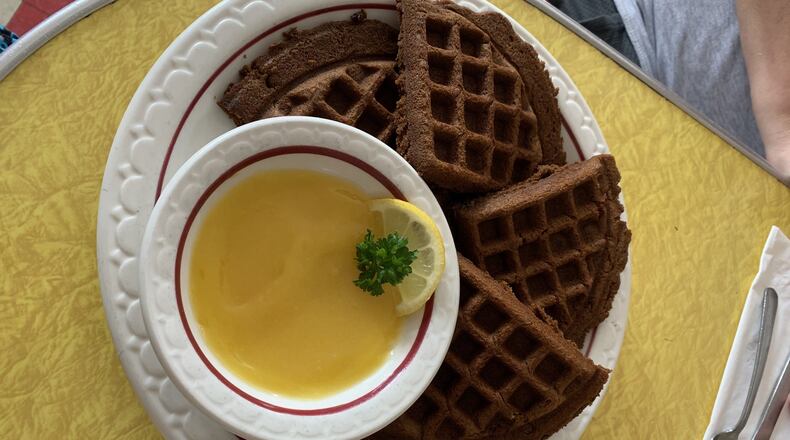When ginger is mentioned, some people immediately think of the knobby root’s reputation as a folk medicine, especially good for settling upset stomachs.
Others associate the warm, zesty, slightly sweet spice with Caribbean or Asian cuisines, or as a way to add some oomph to soups, bisques or marinades. I have a friend who nearly always has fresh ginger root on hand to grate and toss into his stir-fry meals. Ground or fresh, it can be used to season everything from fish, chicken and beef to winter squash, fruit and tea.
But, for many, what comes to mind first are various sweet treats, from the gingerbread figures and houses that seem ubiquitous at Christmastime, to ginger ice cream, cookies with a gingery snap and candied ginger. It’s also a good way of adding some zing to pumpkin or zucchini bread.
I think my taste for ginger dates back to the fresh-baked gingerbread men we used to get when I was young at A&A Bakery in Athens, the best-smelling store I ever entered.
Ginger is one of the few herbs that works equally well in sweet and savory dishes. It can be the dominant flavor, but it also plays well with other flavors, particularly citrus, as I experienced when we had Sunday brunch recently at Java Jive, across from the Hotel Clermont on Ponce de Leon Avenue. I tried their dark brown gingerbread waffles, served with lemon curd on the side. Available only on weekends, it's a delicious, refreshing departure from the usual brunch dishes.
Ginger is indigenous to China, from which it spread to India and then followed the trade routes around the world.
Gingerbread (and the "houses" built from it) showed up in Germany in the 16th century, and it became popular in England during the reign of Queen Elizabeth I, later catching on in the American colonies (where it was made with molasses). George Washington's mother served her version to the Marquis de Lafayette.
No wonder my wife, Leslie, and I encountered warm, aromatic 1700s-style gingerbread at the Raleigh Tavern when we honeymooned in Colonial Williamsburg, which says its version was young Thomas Jefferson’s favorite cookie.
Later, on trips to visit my mother’s family in Britain, I discovered McVitie’s ginger nut cookies (much like ginger snaps) and Walker’s stem ginger biscuits (cookies featuring candied ginger bits), and those became favorites, too.
However, I think the way I've most frequently enjoyed ginger is in drinks. As a boy, I discovered Alabama-based Buffalo Rock "Southern Spice" ginger ale in the cooler in the back of Barnett's Newsstand in Athens — much darker and tastier than that pale, bland Canada Dry variety my brothers and I associated with being sick at home.
The "golden" or spicier ginger ales mostly seem to be regional concoctions. In the Midwest, the preferred choice is Vernors. In much of the South, it's South Carolina's Blenheim, which comes in three varieties denoted by the color of the bottle cap: gold for regular (or NAH, for "not as hot"), red for hot and white for diet. The regular has a sweeter, fruitier taste than most ginger ales.
Of the varieties I've tried, the one with the most ginger kick is Buffalo Rock, which leaves a mild burning sensation in the back of the mouth. Atlanta-born Red Rock ("Just the right bite!") runs a close second.
You can’t swig Buffalo Rock or Red Rock. The first time I ever had a Red Rock was in the mid-’60s at a golf course near Canton, where I was caddying for my father while we vacationed on Lake Allatoona. I was thirsty from pulling his cart, and I took a deep chug of the reddish golden drink. My eyes nearly popped out, and I thought my throat was on fire.
Being an Athens native, I was pleased recently to discover another spicy ginger ale, Ginger's Bunkhouse, which hails from my hometown. It was created by Joey Tatum for his Manhattan Cafe bar. He'd been using Blenheim's for years in his best-selling cocktail (spicy ginger ale with Maker's Mark bourbon), but, when distribution problems made Blenheim hard to obtain for a while, "I went in my kitchen and worked up a batch of ginger ale and started selling it," he said.
It’s named after Ginger, one of his twin daughters, with Bunkhouse being a compromise when he discovered his original choice, Ginger’s Clubhouse, already was trademarked.
Tatum decided to go for a drier taste with Ginger’s Bunkhouse, which makes it probably better as a mixer than as a stand-alone sipper. “Most ginger ales are kind of sweet,” he told me, “and I wanted to do something that would differentiate mine from Blenheim’s.”
Tatum's "side project," a 2018 Flavor of Georgia finalist, is bottled for him in Tennessee, and currently is available in a handful of Athens stores, and at My Dad's Basement in Avondale Estates and at Atlanta's Grant Park Market. Tatum and his wife Emily, who also own Little Kings Shuffle Club bar in Athens, are "taking it kind of slow," he said, but hope soon to have distribution throughout metro Atlanta.
Speaking of cocktails using ginger ale, I mostly had stuck to craft beer in recent years, but, a couple of years ago, my daughter was reading out of my mom's journal about the 21st birthday party that my grandmother in Wales threw for my dad, a U.S. soldier stationed in their town in the run-up to D-Day. She served ginger beer, which, unlike ginger ale, is brewed and fermented.
I'd never had ginger beer (most brands of which are considered nonalcoholic), so I tried it. At my daughter's suggestion, that led me to the Moscow Mule — consisting of vodka, ginger beer and lime juice — and its various iterations (Down Under Mule, Montana Mule, Alpharetta Mule and even the Chief Knockahoma, served at our neighborhood restaurant, Pea Ridge, and not called a mule because they don't serve it in the traditional frosty copper mug).
Whatever it's called, the mule has become my new go-to dinner cocktail. I've also noticed a lot of other drinks made with ginger beer, including my son's choice, the Dark and Stormy (using rum, rather than vodka), and the similar Captain and Ginger, currently advertised on TV by Captain Morgan spicy rum, with soccer fans singing a jingle to the tune of "Guantanamera."
As far as I’m concerned, there’s not much that wouldn’t be improved by a dash of ginger. Still, I think gingerbread is my favorite use of the spice.
A&A Bakery in Athens is long gone, unfortunately, but I was pleased to find out recently that Colonial Williamsburg has adapted its gingerbread into "ginger cakes," and sells them online in boxes that look like the famed Raleigh Tavern.
Zap them for a few seconds in the microwave, and you could swear they’d just been served up from fresh from the hearth!
Bill King is a retired writer-editor for The Atlanta Journal-Constitution. He can be reached at junkyardblawg@gmail.com.
RELATED:
Read more stories like this by liking Atlanta Restaurant Scene on Facebook, following @ATLDiningNews on Twitter and @ajcdining on Instagram.
About the Author
Keep Reading
The Latest
Featured






